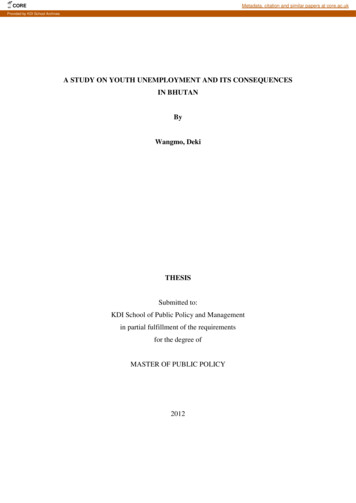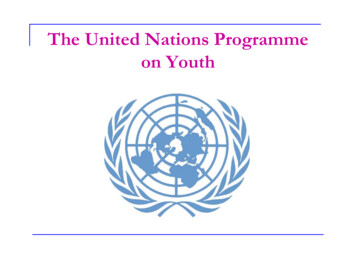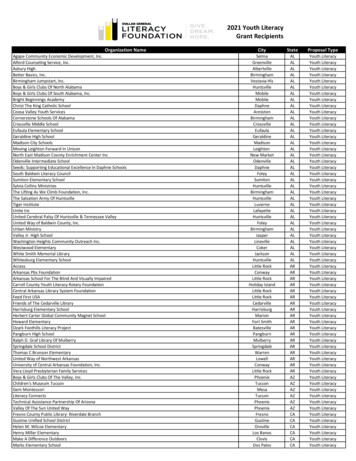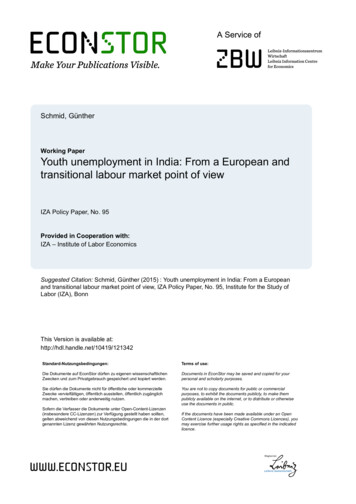
Transcription
COREMetadata, citation and similar papers at core.ac.ukProvided by KDI School ArchivesA STUDY ON YOUTH UNEMPLOYMENT AND ITS CONSEQUENCESIN BHUTANByWangmo, DekiTHESISSubmitted to:KDI School of Public Policy and Managementin partial fulfillment of the requirementsfor the degree ofMASTER OF PUBLIC POLICY2012
A STUDY ON YOUTH UNEMPLOYMENT AND ITS CONSEQUENCESIN BHUTANByWangmo, DekiTHESISSubmitted to:KDI School of Public Policy and Managementin partial fulfillment of the requirementsfor the degree ofMASTER OF PUBLIC POLICY2012Professor Kim, Kyong-Dong
ABSTRACTA study on Youth Unemployment and its Consequences in Bhutan,ByWangmo, DekiFrom the beginning of the 20th century, unemployment was articulated as an alarming issuein the world. In particular, youth unemployment has gained its concern by wake of the 21stcentury.There are varying ideas and thoughts about the effects and causes of unemployment in theworld. The consequences of unemployment are not short lived; rather they create a suddendisorder in the society, prolonging a long term effect. The impact will be felt rather with a“ripple effect” with very negligible start at one point, eventually loading with an extensiveimpact to the society, then to the nation and the globe in the long run.Theoretically unemployment is entirely a new issue in context of Bhutan. Bhutan started itssocio –economic development after the 1960s and since then like any other developing nation,Bhutan started raising concern for the state of joblessness of the its people, particularly theyoung people in the country.The issue of unemployment started gaining momentum in the country by 1990s when thecountry addressed its socio economic development and the concern over increasing growthrate of the population and the rising number of youth.Increasing enrollments, Mismatch of Jobs & skills required, Rural-Urban Migration andLeast preference of jobs in the private sector were some factors contributing to rising youthunemployment in the country. Consequently there are believed notions that unemploymentlead to occurrence of social evils such as increasing number of alcohol & drug abuse, youthviolence such as theft, vandalism and many more.With this study it was evident that unemployment alone did not contribute to emergence ofthe social evils in Bhutan. There were many other contributing factors such as issues withfamily affairs, weak parental guidance, loss of sense of belonging and many other factors.i
Copyright byWangmo, Deki2012ii
ACKNOWLEDGEMENTSThe completion of this thesis was possible with tremendous help and support from manyimportant people in my life.I want to express my heartfelt gratitude to Prof. Kim, Kyong-Dong, my advisor who was kindenough and agreed to be my thesis supervisor despite his busy schedules and many otherurgent engagements. Prof. Kim provided his relentless guidance and support which were verycrucial and important aspect for completion of this thesis successfully.I would like to express my sincere gratitude to my course supervisor, Prof. Shin, Jaeun forher valuable guidance and suggestions while writing this thesis. Her constant encouragementright from the beginning of the session was my main source of inspiration and survival guidein KDI School.I want to sincerely thank Professor. Hongik Chung and Prof. Sieth Leighton for their constantsupervision and direction which helped me further improve this thesis.I also would like to thank the librarians, the IT personnel and other support staff for providingme with all the required support and help during the research period.I would like to thank Mr. Phub Sangay, (National Statistical Bureau), Mr. Sangay Thinley(Center for Bhutan Studies), Captain Dechen, (Royal Bhutan Police), Ms. Phuntsho Eden(Statistician, MoLHR), Mr. Ugyen Tenzin (Statistician, MoLHR), Lama Zhenphen Sangpo(Deer Park) and my colleagues for providing me with their support and ideas during theresearch and survey for this Thesis. Thank you all once again for sharing your thoughts andyour support and making this thesis possible in time.Last but not the least, I would like to thank my family and friends for their continued supportand encouragement. I would specifically want to thank my sisters Dechen and Yangchen, fortaking care of my family matters, while I was away from home. You all have been source ofmy inspiration and motivation which helped me tremendously in completing this thesis.Thank you all.iii
DEFINITIONSYouth: A person aged between 15-24 years of age.Unemployed: Unemployed are those people who did not have a job or business or were notemployed. Unemployed is based on three categories which are to be followed simultaneously.They are; ‘without work’, ‘available for work’, and ‘seeking work’.Unemployed Youth: A person aged between 15-24 years of age who is ‘without work’,‘available for work’, and ‘seeking work’.Employed: If a person has performed some paid work in cash or in kind, during the referenceperiod for at least one hour or the person has a job or business formally attached buttemporarily absent from the work and going to resume the work.Employer: A person who employs at least one person in his/her enterprise directly orthrough another person whom he pays in cash or in kind.Migration: The movement of people across a specific boundary for the purpose ofestablishing a new or semi permanent residence.Work: According to ILO standards and United Nations 1993 System of National Accounts,work includes any kind of works or businesses including collecting water or firewood, cowherding, tailoring or making mates, etc. even for the households’ own consumption.Examples of activities which are counted as a workActivities counted as work Growing or gathering crops from the field, producing eggs, milk, food, cow herding,etc. Milling and other food processing activities, milling grains, making butter and cheese,brewing local wine, etc. Yarning and weaving clothes, making baskets and mats, peat making, tailoring, andmaking furniture, etc Construction of own house/buildings, major renovation of private roads and otherprivate facilities. Fetching water, cutting or collecting firewood. Activities of a religious order and rituals.Activities not counted as work Preparing and serving meals Unpaid family member (baby-sitting, training & instructing children, transportinghousehold members/goods, repairing household durables, vehicles or other goods,etc.)Source: Labour Force Survey Report, MoLHR 2010iv
MoLHRNSBOECDRBPRICBLSAARCRCSCRUBUNDPTTIBhutan Narcotic Control AgencyCentre for Bhutan StudiesDepartment of LabourDepartment of EmploymentFive Year PlanGross National HappinessGross National Happiness CommissionHuman Resource DevelopmentInternational Labour OrganizationInstitute for Zorig ChusumLabour and Employment Act, 2007Labour Force Participation RateLabour Force SurveyMinistry of Labour and Human ResourcesNational Statistics BureauOrganization of Economic Cooperation & DevelopmentRoyal Bhutan PoliceRoyal Insurance Corporation of Bhutan LimitedSouth Asian Association for Regional CooperationRoyal Civil Service CommissionRoyal University of BhutanUnited Nations Development ProgrammeTechnical Training Institutev
TABLE OF CONTENTS1. INTRODUCTION1.1 Research Problem1.2 Objectives1.3 Theoretical Background2. LITERATURE REVIEW2.1 Information related to unemployment2.2 Related theories2.3 Similar Research3. RESEARCH METHODOLOGY3.1 Population and Sample3.2 Research instruments4. FINDINGS AND OBSERVATION5. RECOMMENDATIONS6. CONCLUSIONS7. REFERENCEvi
LIST OF FIGURESFigure 1: Enrolment Scenario since 1961 till date . 10Figure 2: Graduates and school leavers in Ninth Plan (Supply Projection) . 11Figure 3: Projections of Demand for Employment in Various Sectors in Ninth Five year Plan . 12Figure 4 Cross tabulation for Q2 (Sex) and Q.5 (Academic Qualification). 22Figure 5. Cross tabulation of Q.5 (Academic Qualification) and Q.1. (Age) . 22vii
1. INTRODUCTION1.1 Research Problem:Bhutan is a small landlocked country located, both economically and demographically,between two giants; China in the North and India in the South. In the past, Bhutan remainedisolated with high mountains in the North and the thick impenetrable forest in the south andthe people lived in seclusion until the 1960s, relying on agriculture and the forest for theirsurvival.Development in real context started from early 1960s when the third King of Bhutan, the lateMajesty Jigme Dorji Wangchuk, opened its doors to the outside world - starting the first fiveyear plan in 1961- 1966.The first and second five year plans were focused on social andinfrastructure development. By the end of the first plan period (1965), there were 108 schoolsestablished with enrollment of 15000 students, 40 health dispensaries and three majorhospitals were established in the country (GNHC. 2009). Since then, development hasprogressed steadily with each plans and establishment of schools and small health units hasprogressed further to cater education and medical facilities to the people in the country.By the mid 1980s, there has been steady growth and development of the economypredominantly with hydro power, tourism and other medium and small industries. Lessonslearnt from developed countries elsewhere shaped Bhutanese development plans to proceedcautiously. The development path of the country has been focused on social well being andhappiness of the people, guided by the principles of Gross National Happiness.Gross National Happiness is a development Philosophy articulated by His Majesty, KingJigme Singye Wangchuk, the 4th King of Bhutan since 1972 (Karma Ura, 2009). In order tomeasure the developmental indicators, the Gross National Happiness Index (GNH Index) wasdeveloped in November 2008, highlighting the need to balance spiritual, emotional and1
material development as an effective means to achieve true happiness. Yet, in the process ofdevelopment, like any other developing country, Bhutan has not been able to evade thetribulations of the process of transition in the period of globalization. One such probing issuethat the country is facing currently is youth and their unemployment situation in the country.Over the last decade, Bhutan has witnessed a rise in unemployment rate from 1.4% in 1998 to4.0 % in 2009 as per the Labour Market Information Report, 2009 from Ministry of Labourand Human Resources. Amongst this, the young people between the ages of 15-24 yearsconstitute 59% of the total unemployed population.Theoretically, unemployment in context of Bhutan is entirely a new issue. Bhutan started itssocio –economic development after the 1960s. The period before that the country wasabsolutely agrarian and dependent on farming. Owing to such facts that everyone worked infarms, a new born in the family meant a new helping hand in the farm. “An extra hand wasnot just an extra mouth to feed, but a resource as well” (Kinga, 2005).With introduction of modern education in early 1960s, (vision 2020), young children wereencouraged to enroll in school and with time, the enrollment in the schools increased leadingto an increase in number of young graduates entering the labour market. However, the jobsin the Civil Service remained numbered, with few significant openings outnumbered by theincreasing numbers of graduates. For instance in 2011 the total number of universitygraduates were 1654, but the total jobs provided by the RCSC was only for 399 graduates.The concern of Youth unemployment is primarily within the educated youth and not theuneducated children of farmers. The data analysis provided by the Ministry of Labour andHuman Resources, revealed that youth unemployment is not a phenomenon occurring evenlyacross villages and towns, but rather confined more in to the urban and educated section ofthe society. (Labour Force Survey, MoLHR, 2009.)2
There are various reports and documents published which concern the youth; theiremployment and its causes, consequences and so on. Most of these documents portray thetrends, the causes and consequences. With time, there have been changes in the scenario ofthe labour market and there are certain significant changes which occurred over a period oftime. One such issue can be the emergence of forced prostitution and increasing cases of drugaddiction which leads to the rise of socially unfavorable incidences like teenage pregnancies,suicides, thefts and many others.With its constant rise, youth unemployment has become a global concern in the 21st century.Several studies were carried out by various economists and social scientists. When a personremains unemployed for a long period of time, they tend to live a destructive live, whicheventually would cause them mentally and physically inactive and unsound leading todisruption in social disharmony. “Adolescences imply a series of status passages. Youngpeople have to make transition in their educational career – from primary to secondaryeducation and eventually on to tertiary education. They also have to make the transition aswell from school to work, from the parental home to a household of their own” (Meeus et al.,1992, as cited in M.P.M,, 1996).1.2 ObjectivesWith rising unemployment in the country there are various consequences which particularlyaffect the youth and their lives. Therefore, this study aims to examine the causes of youthunemployment and the undesirable consequences of youth unemployment, focusing on theproblems of crime and deviant behaviours of the youth. This study will also attempt toinclude the consequences of youth unemployment and recommendation in terms of policyinterventions as well as contributions at individual level, to curb down such issues for nowand in the longer period of time.3
2. LITERATURE REVIEW Theoretical backgroundUnemployment is not entirely a recent phenomenon. It existed during the pre classical era,but its implication took precedence only after the post World War era. From his book“Unemployment and the Economists” Bernard Corry stated that it was Keynes who first gaveimportance to this so called “mercantilist literature”, later elucidated by other economists.The unemployment problem was not a priority during the classical period. Rather, povertywas given more importance. However, by the late 19th century, the issue of poverty andunemployment both became priorities. The unemployment issue became very dominant bymid 20th century, especially during and after World War II, owing to the situation during andafter the war, which demonstrated that a fully employed economy would enhance the profitsin the National Income. (Corry, 1996).The neoclassical theory and the General Theory/Keynesian Theory are two theories, whichexplain the theoretical basis of unemployment. The neoclassical theory analyzes the standarddemand and supply to the labour market and treats unemployment as a ‘disequilibriumoccurrence‘ that arises from the prevalence of wages at a level higher than that which clearsthe labor market. “Minimum wage legislation, union bargaining, and efficiency wages (wherehigher wages produce better workers or draw better workers from the employment pool) aresome of the reasons that labor markets may not adjust to full loyment-theories.html). On the other hand Keynes’stheory states that unemployment results from the equilibrium of aggregate demand andsupply at a level too low to require the productive services of the entire labor force. Theremedy is to raise aggregate demand by a combination of fiscal and monetary measures, suchas lower taxes, increased government spending, or accelerated monetary growth. Protectivemeasures in the realm of international trade, such as tariffs and subsidies, can also help4
alleviate the problem by switching demand from foreign to domestic goods and services(Calhoun, 2009).There are varying ideas about the effects and causes of unemployment in the world. It is awell known fact that one of the burning issues of modern time is unemployment, yet there areclaims that having a certain percent of unemployment can be “healthy”, according to studiescarried out by the International Labour Organization in 1996. They believe that the increasingrate of unemployment is normal or acceptable for having a balance in the economy of acountry. However, the ILO acknowledges that achieving employment is wanted by everyone,as socially and individually none of us want to remain and feel worthless. “The current highlevels of unemployment may represent an economic equilibrium according to “natural rate”theories but it is certainly not an equilibrium that is acceptable on social grounds” (ILO,1996). The potential mental consequences of unemployment are very immense, which wouldlead to social ills imprinting self destruction and causing damages to the societies which willcontinue for a long time to come.From the beginning of the 20th century, unemployment was articulated as an alarming issuein the world. Yet, there had been failure in not being able to create full employment to whichthe economists states that “they are not in control of policy and hence cannot be pilloried forthe failures of the economic system to create jobs for all” (Corry, 1996). Lately gendermainstreaming has taken major significance in defining unemployment. Initiallyunemployment was a male oriented phenomenon owing to the fact that duringindustrialization the full time participation in the Labour market was male, while femaleparticipation was either part time or seasonal. Yet to these days the role of female has greatersignificance in the workplace as well, evolved throughout from a stereotype notion ofhousekeepers to equally strong and willing to work in the fields as the men folks. Probablythis is one reason for rising female unemployment which has become a greater concern.5
The OECD and the ILO gathered data from various countries, which include the developed,transitional and developing countries which reveals that the unemployment is significantlyhigher in the case of young people. It also indicates that unemployment is significantly higherin the case of young people with lower level of education followed by the disabled and youngwomen. From the context of country experiences, it shows one of the main causes as the poorperformance of the country. Based on such available information it was suggested that thefocus of any developing any policies for curbing down youth unemployment should be givento that particular section of the young people without education, as opposed to young peoplein general.The Global Trend of Employment Report (ILO, 1996) states that prior to the beginning of theeconomic crisis in the world, young people were 2.8 times as likely to be unemployed thanwere adults at the global level. Therefore, it is a concern that the impact of the economiccrisis has been particularly harsh for youth, who face a global shortage of employmentopportunities as they will be entering the labour market. Studies carried out by the ILOpredicted that the number of unemployed youth will increase by between 4.9 million and 17.7million from 2008 to 2009. The youth unemployment rate is projected to increase from 12.2per cent in 2008 to between 13.0 and 15.1 per cent in 2009. For adults, who make up the bulkof the labour force, the projected increase in the unemployment rate is 0.5 to 1.2 percentagepoints. With constant rise of incidences of joblessness among young people, it has become aserious concern about the consequences which would have numerous adverse effects on theindividuals and the society as a whole Theoretical background on youth unemploymentThe consequences of unemployment are not short lived; rather they create a sudden disorderin the society, prolonging with a “ripple effect” starting at a very negligible level, rising to an6
extensive effect beginning from the society, then to the nation and eventually the globe in thelong run.There are two schools of thought on the long term effects of youth unemployment.Researchers refer to the first explanation as state dependence and second explanation as theheterogeneity.Youth unemployment has both long and short term effects. The early theoretical literaturesrecognized that the effect of youth unemployment for longer period of time later affects theoutcomes of the market which is very critical in the evaluation of government policies thataffect the youth labor market. Its effect will take adverse course of impact which meanstaking the form of lower levels of human resources, reduced wage rates and weakened laborforce participation in the future (Moore, 2003). Moore affirmed that if such effects persistsover a longer period of time, then the policies such as raising the minimum wage andincreasing unemployment benefits could have considerable positives but with hidden costs.On the individual level, long term unemployment has resulted in varied disturbances ofphysical and psychological well being of an individual. Other issues like systolic bloodpressure, consumption of alcohol and increase in crime rates are more among long-termunemployed boys than among others. Therefore youth unemployment is linked withincreased health symptoms, deterioration in health behaviour and increase in drug abuse.In order to have a better approach in addressing its core issues and mitigate down incidences,it is very necessary to understand consequences which has stronger impact on the youth whoare unemployed for longer or shorter period of time.With theories at the background, there are additional issues existing at the forefront of oureveryday life. These are practical realities of unemployment of the young people, which7
require immediate mitigation or otherwise will affect the society, nation and eventually theentire globe.Generally the normal consequences related to youth unemployment are socially disturbingoutcomes such as drug and alcohol abuse, and, premature pregnancies in young girls, so onand so forth. Furthermore the affect is dominant amongst the most endangered section ofsociety which includes the school dropout, those with deficient school career and workingclass minorities. (Petersen & Mortimer, 1994).The circumstances in Bhutan is no different than rest of the world, though the occurrence ofsuch incidences seems lower owing to its population of just seven hundred thousand, withwhich it is clear that it is an area of concern.Regardless of the theory, Incidences from other countries reveal that youth unemploymentcomprises major public health problem, showing the symptoms both physically andpsychologically which to a certain extent remain throughout their adult age. The study wascarried out for 14 years follow up of group of school leavers, in Sweden.Idleness and risky behaviour is another dreaded consequence resulting from youthunemployment. This is one prominent depiction that we witness almost everywhere in mostof the societies, especially in the developing countries like Bhutan. In context of Bhutan, therising number of juvenile crimes, theft, drug addictions, and many other social issues arestated to be the consequences of unemployment amongst youth. (BNCA, 2005).The previous literatures reveal that there are ample initiatives being taken by governmentagencies and the Nongovernmental Organizations all over the world. Yet, as the issues arevery grueling, the efforts are overcome by the problems. Therefore, it is very valid to say thatthere is a constant increase in number of the unemployed youth and it has become so probing8
that there is urgent necessity for the concerned agencies to improve on their existinginitiatives and possibly improve with dynamic methods and ideas. This doesn’t mean thatonly agencies should be responsible, but it is also responsible for every individual tocontribute in every little way towards eliminating such problems or at least to help curb downsuch problem in the near future.Like any other developing nation, Bhutan started raising its concern for the state ofjoblessness of the young people in the country. This issue started gaining momentum by1990s when the country addressed its socio economic development and the concern due toincreasing growth rate of the population and the increasing number of youth. Causes of UnemploymentOver the last decade, Bhutan has witnessed a rise in unemployment rate from 1.4% in 1998 to3.7% in 2007 to 4.0% in 2009 as per the Labour Market Information Report from theMinistry of Labour and Human Resources. Amongst this the young people between the ages15-24 years constitute 59% of the total unemployed population of the country. Likewise, theyouth unemployment rate increased from 2.6 in 1998, to 9.2 by 2010. This indicates a rapidrise in unemployment amongst youth in the overall picture of the unemployment scenariowithin the time period of only a decade.The following are some prominent scenario and factors of the unemployment situationamongst the youth in the country:I.Increasing EnrollmentObserving the data available from the early 1960s, it is apparent that the enrollment in theschools all over the country started increasing yearly. Expansion and improvement ofeducation facilities, along with development of transport and communication facilities, led togrowing numbers of children going to school.9
With the progress in development of the country, there had been extensive improvement inthe education and health facilities which made significance changes in the lives of the people.Since then, the enrollment of the students kept increasing annually. The following figure isprepared with information from the annual statistical year books from the Ministry ofEducation which gives us a broader picture of the situation of enrollment over the period oftime.The figure below shows the total yearly enrolment of students -Pre-school, Primary andSecondary education-, which records the enrolment statistics from 1961 till 2009. Observingthis figure it is valid to say that there had been significant increase in enrollment.Figure 1: Enrolment Scenario since 1961 till dateSource: Annual Education Statistics, 2009On the other side, the annual increase in enrollment indicates an increasing supply of a largenumber of jobseekers in the labour market in years to come. Over the period of time, it is aconcern that this number will outnumber the jobs available in the market, which can beillustrated with the example from the supply and demand projection made in the followingtables for the ninth five year plan. For instance, the total supply projection is 49, 200 and thedemand projection is 45,810, which would be leaving a balance of 3390 surplus in the labourmarket.10
Figure 2: Graduates and school leavers in Ninth Plan (Supply Projection)SI. #Level of Education Job seekersJob seekers1Class VIII to XII27,2002Graduates (including teachers from NIEs)47003Technical Training Institutes17,3004Total49,200Source: Department of Labour, MoLHR, 2004 (youth, development and employment inBhutan, pg. 43)11
Figure 3: Projections of Demand for Employment in Various Sectors in Ninth Five yearPlanSI. #Employment opportunitiesVacancies1.Civil Service (including 2,100 teachers)60002.Armed Forces (including officers)76003.Corporate and Private Sectors4.Agro-based Industries23185.Forest-based industry20806.Mining and Manufacturing45007.Construction79478.Trading and tourism129759.Information Technology79010.Other Services160011.Total45810Source: Department of Labour, Ministry of Labour and Human Resources, 2004 ascited in the youth, development and employment in Bhutan, pg. 46)12
II.Mismatch of Jobs and the skills required:A pertinent issue which has valid correlation with increasing enrolment is the mismatch ofskills in the job market. Observing figure 1 and figure 2, it is evident that there are jobseekerswith various levels of qualification, yet they do not have related skills which would equipthem to match with the jobs available in the job market. Another scenario is that there areyoung people looking for jobs in the market, but the employers in the private sectoremployers prefer the ones with prior job experiences. Employers normally do not wantemployees who are fresh out of school without prior skills and experience. Therefore it isobvious that mismatch of demand and supply is significant matter of concern in this context(Kinga, 2005).III.Rural-Urban MigrationThe phenomenon of rural-urban migration also has a significant role in growing the urbanyouth unemployment situation in the country. In a way, the migration does have a correlationwith increasing enrolment in the general education system in the country. Increasingenrollment leads to rise in number of entrants of youth in the job market. Since it is possibleto find off-farm jobs in the urban areas, the young jobseekers from the rural areas flock tocities and towns looking for jobs. This would also mean decreasing number of workers in thefarms and agricultural activities in the rural areas. The UNDP’s Human Development Report2009 revealed that Bhutan’s internal migration rate at 6% which is considered to be highest insouth Asia.“Bhutan’s urban growth rate on an average today is more than seven percent. This hasresulted in the reduction of work force in the agriculture sector, under-utilisation of13
established infrastructure in rural areas and housing shortage and unemployment in urbanareas” ( Kuensel, News paper, October 22, 2009). It is definite to state that with emergence ofsuch phenomena, there is gradual emergence of problems such as urban sprawl, squattersettlement, shortage of basic facilities, and so on.IV.Skilled Jobs and For
Work: According to ILO standards and United Nations 1993 System of National Accounts, work includes any kind of works or businesses including collecting water or firewood, cow herding, tailoring or making mates, etc. even for the households' own consumption. Examples of activities which are counted as a work Activities counted as work











